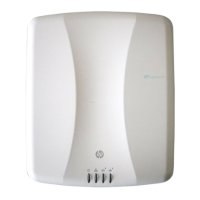Wireless configuration
Radio configuration
3-28
Tx beamforming
Supported on: E-MSM430, E-MSM460, E-MSM466
Not available in Monitor or Sensor modes.
Tx beamforming can be used to help increase throughput by improving the quality of the
signal sent to wireless clients
When this option is enabled, APs use beamforming techniques to optimize the signal strength
for each individual wireless client station. Beamforming works by changing the
characteristics of the transmitter to create a focused beam that can be more optimally
received by a wireless station.
HP APs support the following two explicit beamforming techniques:
Non-compressed beamforming, in which the client station calculates and sends the
steering matrix to the AP.
Compressed beamforming, in which the client station sends a compressed steering
matrix to the AP.
Radio calibration is not required to use either of these two methods.
Note Beamforming only works with wireless clients that are configured to support it.
RTS threshold
Not available in Monitor or Sensor modes.
Use this parameter to control collisions on the link that can reduce throughput. If the Status
> Wireless page shows increasing values for Tx multiple retry frames or Tx single retry
frames, adjust this value until the errors clear. Start with a value of 1024 and decrease to 512
until errors are reduced or eliminated. Note that using a small value for RTS threshold can
affect throughput. Range: 128 to 1540.
If a packet is larger than the threshold, the AP holds the packet and issues a request to send
(RTS) message to the client station. The AP sends the packet only when the client station
replies with a clear to send (CTS) message. Packets smaller than the threshold are
transmitted without this handshake.
Spectralink VIEW
Supported on: MSMS310, MSM320, MSM335, MSM410, MSM422
Not available in Monitor or Sensor modes.
Provides support for Spectralink phones using Spectralink Voice Interoperability for
Enterprise Wireless (VIEW) extensions.

